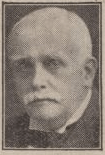Ernest MacBride facts for kids

Ernest William MacBride (born December 12, 1866, in Belfast; died November 17, 1940, in Alton, Hampshire) was an important British/Irish marine biologist. He was one of the last scientists to support an idea called Lamarckian evolution.
Contents
Ernest MacBride: A Life in Science
Early Life and Education
Ernest MacBride was the oldest of five children. His mother was Minnie Browne, and his father, Samuel MacBride, owned a linen factory in Belfast. Ernest went to school at the Academical Institute in Belfast. He also spent a year studying in Neuwied, Germany.
Later, he continued his education at Queen's College, Belfast. He also studied as an external student at London University. He then went to St John's College, Cambridge, where he earned a scholarship in 1891. In 1893, he became a Fellow there.
Research and Teaching Career
In 1891 and 1892, MacBride spent a year doing research. He worked at the Zoological Station in Naples, Italy, with a scientist named Anton Dohrn. After returning to Cambridge, he became a university demonstrator. This meant he helped teach about animal shapes and structures. In 1893, he won the Walsingham Medal for his biological research.
In 1897, MacBride moved to Canada. He became the first Strathcona Professor of Zoology at McGill University. While in Canada, he married Constance Harvey Chrysler. In 1905, he was chosen as a Fellow of the Royal Society. This was a great honor for his work on Echinoderms, which are sea creatures like starfish.
In 1909, MacBride left McGill and returned to the United Kingdom. He worked at Imperial College London as an assistant professor of Zoology. When his boss, Adam Sedgwick, passed away in 1913, MacBride took over as professor. He held this important position until he retired in 1934.
His Scientific Ideas
MacBride was especially interested in Echinoderms. He studied their shapes and how they developed from embryos. He was a strong supporter of Lamarckian evolution. This idea suggests that living things can pass on traits they gain during their lifetime to their children. For example, if an animal develops stronger muscles from exercise, Lamarckism would suggest its offspring might be born with slightly stronger muscles.
MacBride even supported claims by another scientist, Paul Kammerer. Kammerer said he had shown Lamarckian inheritance in the Midwife toad. MacBride also believed that differences between human groups were shaped by their environment. He did not agree with the idea of genes. He also rejected the mutation theory of evolution. This theory says that evolution happens through random changes in genes.
MacBride was very active in scientific groups. He served on the council and as vice-president of the Linnean Society. He also served on the council of the Zoological Society for over thirty years. He was also a vice-president there.
Works
- Text-book of embryology. Vol. I: Invertebrates, 1914
- (with A. E. Shipley) Zoology ; an elementary text-book, 1915
- An introduction to the study of heredity, 1924
- (tr.) Biological memory by Eugenio Rignano, 1926
- Evolution, 1927
- The idea of memory in biology, 1928
- (with H. R. Hewer) ‘Zoology’, in Alfred Piney, ed., Recent advances in microscopy; biological applications, 1931
- ‘The oneness and uniqueness of life’, in Frances Baker Mason, The great design; order and progress in nature, 1934
- Huxley, 1934

